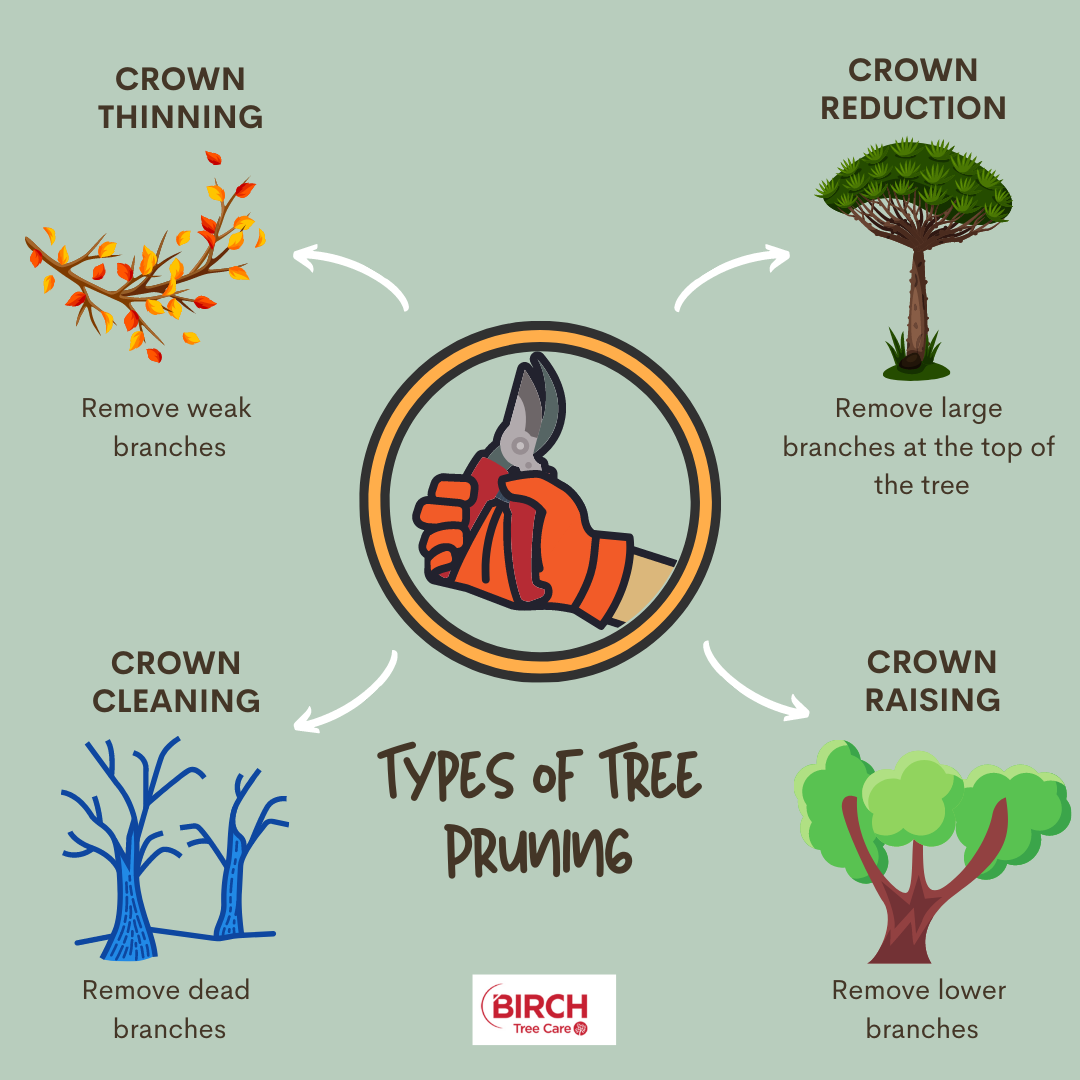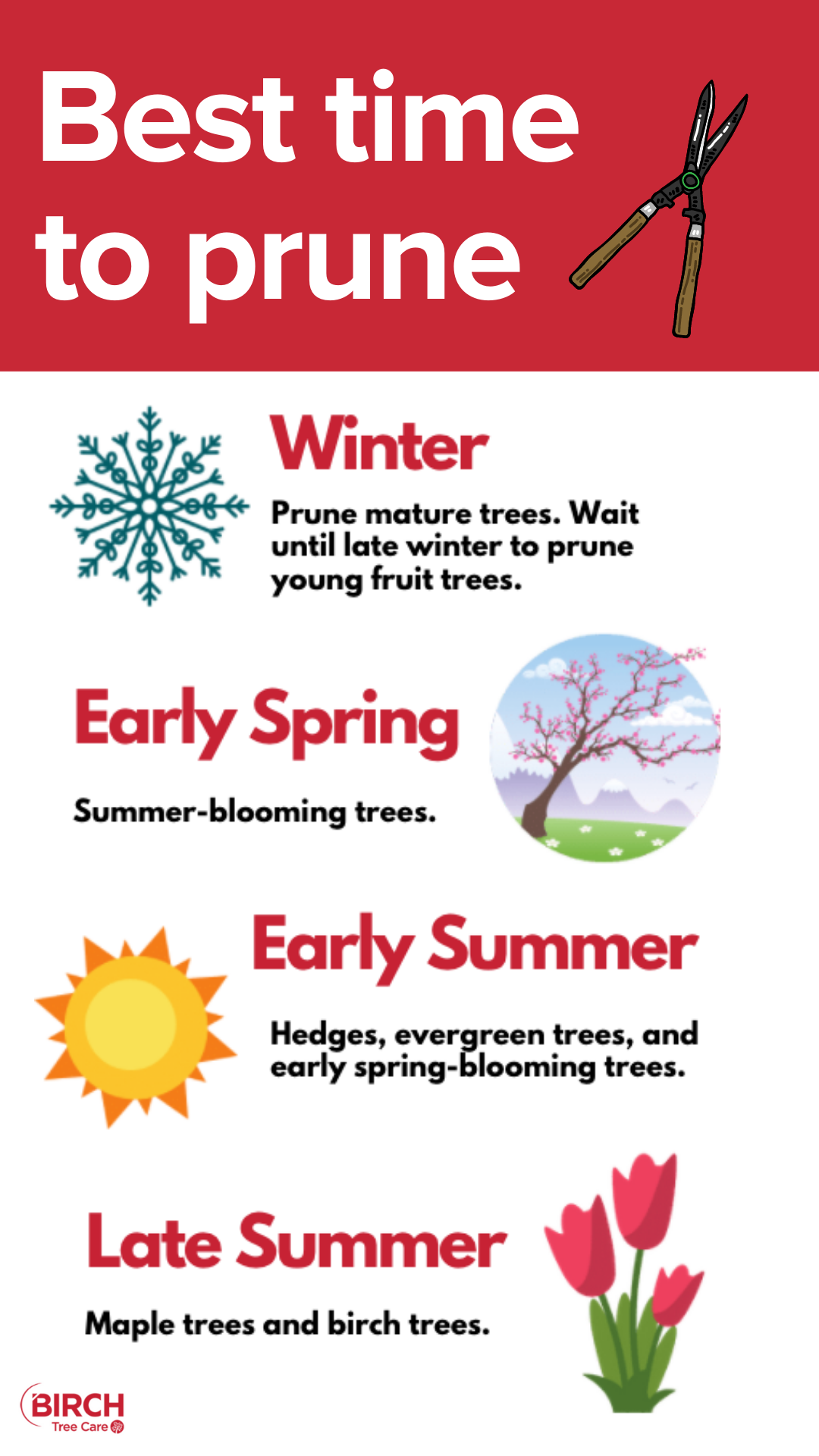Tree pruning is an essential part of maintaining the health, safety, and aesthetics of your landscape. In Minnesota, where the climate is unique with its cold winters and humid summers, it’s particularly important to understand the best times to prune your trees.
Proper pruning not only helps keep your trees healthy but also promotes strong growth, ensures safety by preventing overgrown branches, and enhances the overall appearance of your property. Understanding whether trees bloom on previous season's growth or current season's growth is crucial, as it affects the timing of pruning to encourage vigorous new growth and flowering.
At Birch Tree Care, we are passionate about helping homeowners and businesses in Minnesota understand the importance of tree care. In this post, we’ll discuss the ideal tree pruning schedule in Minnesota and how to ensure your trees stay healthy and beautiful throughout the year.
Read Our Other Blogs
Why Tree Pruning is Essential for Your Trees
Before diving into the pruning schedule, let’s take a look at why tree pruning is so important.
Health of the Tree: Pruning helps remove dead, diseased, or damaged branches that could hinder your tree’s health. Inspecting and removing diseased wood throughout the year is crucial to maintain the tree's health. This allows the tree to focus its energy on growing healthy, strong limbs.
Safety: Regular pruning removes branches that could potentially fall and cause damage during storms or high winds. In areas with heavy snow and ice, pruning can also prevent limbs from breaking due to the weight of snow.
Aesthetic Appeal: Well-pruned trees look more attractive and are a great addition to your landscape. Proper pruning also helps maintain the tree’s natural shape and structure, contributing to its overall beauty.
Encouraging Growth: Pruning encourages new growth by stimulating buds and allowing better light penetration and airflow to the rest of the tree.
Understanding the Climate: When to Prune in Minnesota
Minnesota has a diverse climate, with cold winters, hot summers, and a short growing season. This can make timing your tree pruning critical for ensuring the best outcomes for your trees. Late winter is an optimal time for various pruning techniques aimed at promoting healthy growth and structure in plants.
1. Winter Pruning (Dormant Season)
The winter months (from late November through March) are the ideal time for tree pruning in Minnesota. During this time, most trees enter dormancy, meaning their growth slows down, and they’re not actively producing new leaves or flowers. Here’s why winter pruning is beneficial:
Less Stress on the Tree: Since trees are dormant, pruning won’t cause as much stress as it would during their active growing season.
Easier to Spot Issues: Without the foliage, you can easily spot dead or damaged branches that need to be removed.
Better Healing: Pruning in winter allows the tree to heal during the dormant season, ensuring a healthier tree when spring arrives.
Deciduous Trees: Winter is an excellent time to prune deciduous trees. It is important to protect freshly cut branches from potential insect infestations that could lead to oak wilt.
Best Trees to Prune in Winter
Deciduous Trees: Maple, Oak, and Birch trees are great candidates for winter pruning. These trees are especially responsive to winter pruning since they are dormant and won’t bleed sap excessively.
Fruit Trees: Winter is also an excellent time to prune fruit trees, such as Apple and Pear trees. Pruning them while dormant encourages robust growth when the tree starts to grow in the spring.
Conifers: Pine, Spruce, and Fir trees can also be pruned in winter to remove dead or damaged branches.
2. Spring Pruning (Pre-Blooming)
Spring pruning typically takes place just before or after the trees begin to bloom, generally in March or early April. This is the time when new growth starts, but it’s still early enough that pruning won’t interfere with the tree’s ability to develop leaves and flowers. The benefits of spring care include:
Stimulating New Growth: Pruning in the spring encourages strong, healthy growth during the growing season.
Preventing Disease: It’s easier to detect signs of disease or pest damage in the spring before it becomes a larger issue.
Best Trees to Prune in Spring
Flowering Trees: Trees like Lilacs, Magnolias, and Dogwoods should be pruned in early spring to prevent disturbing their blooming process. You’ll want to prune them after they’ve finished blooming for the best results. Additionally, it is important to prune shrubs in the spring to enhance flowering and maintain their health.
Small Deciduous Trees: Pruning small trees, such as Hawthorn or Japanese Maples, is also beneficial in the spring to promote a stronger structure for the growing season.
3. Summer Pruning (Post-Blooming)
Summer pruning is typically reserved for trees that have already bloomed and are in full leaf. This time is generally ideal for light pruning or to manage growth during the growing season. It's also useful for shaping and improving the appearance of the tree.
Best Trees to Prune in Summer
Evergreens: Summer pruning helps maintain the shape of Evergreen trees like Pines, Spruces, and Firs.
Late-Blooming Trees: Trees such as Crepe Myrtle and Butterfly Bush are better pruned after they bloom in late spring or early summer.
Fast-Growing Trees: Some trees grow rapidly during the summer, such as maples and oaks. A little pruning can help control their growth and maintain their shape. Pruning trees during summer is essential to manage their rapid growth and ensure they remain healthy and well-formed.
4. Fall Pruning (Post-Leaves Drop)
Fall pruning should be done sparingly in Minnesota, as it can leave the tree vulnerable to frost and damage. However, fall pruning is ideal for removing diseased or damaged branches before the winter season. Dead or damaged branches should be pruned immediately in the fall to prevent them from becoming a safety hazard during winter storms.
Best Trees to Prune in Fall
Non-Flowering Deciduous Trees: It’s fine to prune non-flowering trees like ash or elm in the fall, but avoid pruning them if they’re showing any signs of disease.
Removal of Dead or Damaged Limbs: Fall is an excellent time to remove any deadwood or broken branches, as this will prevent them from becoming a safety hazard during winter storms. Additionally, managing perennials during this time can facilitate growing in the upcoming spring season, promoting healthy spring growth.
Tips for Pruning in Minnesota
Prune with the Right Tools: Always use sharp, clean pruning tools to make precise cuts. Dull tools can cause injury to the tree and increase the likelihood of disease.
Don’t Over-Prune: Pruning too much can weaken the tree. Always aim to remove no more than 20-30% of the tree’s canopy in a single pruning session.
Hire an Arborist: If you're unsure about the right time to prune or how much to remove, it’s always a good idea to consult with a Professional Arborist.
How Birch Tree Care Can Help
At Birch Tree Care, we specialize in providing high-quality tree pruning services to homeowners and businesses in Minnesota. Our Certified Arborists can help determine the best pruning schedule for your trees based on their type, health, and growth cycle.
Whether you need pruning for aesthetic reasons, tree health, or safety, we’re here to help ensure your trees remain strong and beautiful.
Our pruning services include:
Routine Pruning: Maintaining the health and appearance of your trees year-round.
Emergency Pruning: We handle dangerous or urgent situations, such as storm damage or hazardous branches.
Tree Health Assessments: We offer assessments to determine if pruning is necessary and how to proceed.
Contact Birch Tree Care Today for Early Spring Pruning
Pruning is an essential part of tree care in Minnesota. By understanding the best times to prune and tailoring the pruning schedule to the needs of your trees, you’ll ensure that your trees thrive year-round.
Whether you are a homeowner looking to improve the appearance of your yard or a business needing expert tree care, Birch Tree Care is here to provide honest, professional, and safe pruning services. Reach out today to schedule a free consultation or learn more about our services!






